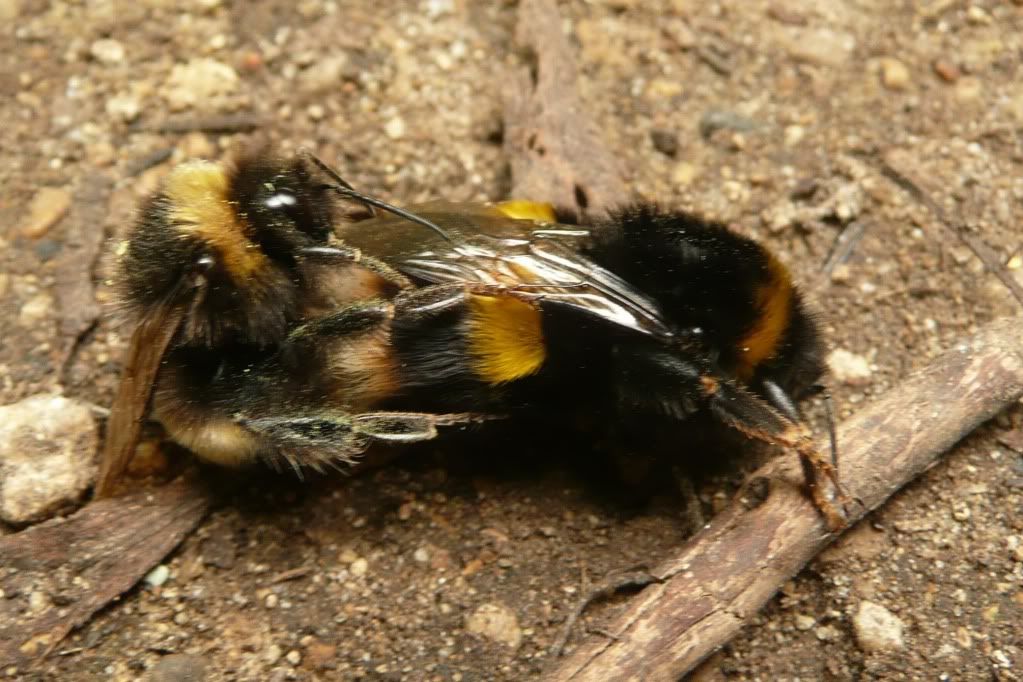As featured in a previous post, now summer is here, male and queen bumblebees are now on the wing.
As the bumblebee nest reaches the end of its life queens and males are produced. The males hatch from unfertilized eggs usually laid by the queen, but sometimes worker bees will produce eggs that will turn into males (if the queen has died or if it is a large nest). The males fly around in what is called a circuit, using scent drops to attempt to attract a queen.
Although individual males and queens are often seen separately, it is unusual to see them in the act of mating. These two were seen along the cycle path to Oxford, near Radley Lakes:
.
.
At first glance they could be red tailed bumblebees (Bombus Lapidarius), but the dark wings on the female and the lack of yellow stripe on the thorax off the male mean they are more likely to be the cuckoo variety (Bombus rupestris):
.
.
For most animals, the act of mating is often short - during this time they are open to predation, they are not feeding and they could be seeking out another mate. But for bumblebees it is an arduous activity (certainly for the queen) and may last for 45 minutes. After mating the male injects the female with 'bung' preventing her from mating (a chemical chastity belt) and it will be the last time she mates. Unlike male honey bees (which die after mating), male bumblebees are free to mate again.
As the queen is weighed down by a male (and sometimes two) she is unable to fly, which can put them in harm's way, like these buff-tailed bumblebees (Bombus terrestris) seen on the footpath along the Ock Valley Walk:
.
.
They were then moved aside to prevent them being crushed (seemingly unfazed about being picked up by a stick and a leaf):
.
.
Unfortunately a different fate awaited this pair along Mill Road, near the Ock, which seem to have spent so long mating that they were not aware of an on coming car:
.
.
References:
Field Guide to Bumblebees of Great Britain & Ireland: Mike Edwards & Martin Jenner
Bumblebees: Christopher O'Toole
Wild About Britain





I watched a group of bumblebees on flower buds last evening. They were still there this morning. Hmmmm... I wonder if this is what they were up to.
ReplyDeletewhen my time comes, that's how i'd like to go! - run over by a car after a steamy 45 minute love fest :)
ReplyDelete2/07/15 my son and I saw a white tailed bumblebee and another bumblebee copulating and flying from one place to another before settling on the trunk of a tree in our garden. Is this unusua.? My son and I both have photos to prove it albeit not too clear.
ReplyDeleteHello and thank you for your comment.
ReplyDeleteI would say it is unlikely that they are different species of bumblebee as each species has a different shaped sexual organs - Bumblebees by Edwards & Jenner has 7 pages on the subject - and looking at them under a microscope is the only definitive way to identify a bumblebee.
You could contact the bumblebee conservation trust (http://bumblebeeconservation.org/contact) or iSpot (http://www.ispotnature.org/communities/uk-and-ireland) who will be able to other an explanation of what is happening.
But from what you've told me, I would say they were actually buff tailed bumblebees - which can look very similar or identical to white tailed bumblebees, these can have different coloured queens, workers and males.
If you want to send me the picture Ockviewer[ at ] gmail.com I can take a look.
I hope this helps.
Have pics....yup, still at it!
ReplyDelete